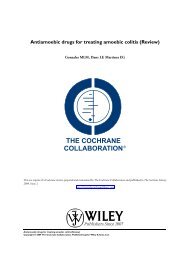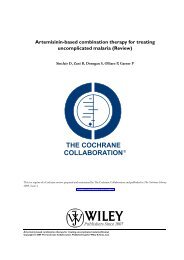Ivermectin for onchocercal eye disease (river blindness) (Review)
Ivermectin for onchocercal eye disease (river blindness) (Review)
Ivermectin for onchocercal eye disease (river blindness) (Review)
You also want an ePaper? Increase the reach of your titles
YUMPU automatically turns print PDFs into web optimized ePapers that Google loves.
(Continued)<br />
Proportion with corneal microfilarial<br />
count > 1<br />
4. Clinical<br />
17/285 61/263 0.21 (0.12,0.37)<br />
Abiose 1993 Dadzie 1989 Taylor 1988 Whitworth 1991<br />
Outcome n/N in ivermectin group,<br />
n/N in placebo<br />
group. One or more doses<br />
(max four) over 3 years.<br />
Mean duration of followup<br />
2.54 years (range 1.41<br />
to 3.25)<br />
Punctate keratitis Not reported “At one year all ivermectin<br />
treated groups showed<br />
a zero level whilst the<br />
placebo treated group was<br />
at 50% of the level be<strong>for</strong>e<br />
treatment”<br />
Figures are geometric<br />
means at baseline<br />
(be<strong>for</strong>e treatment)and 12<br />
months after one dose of<br />
ivermectin<br />
Number<br />
of punctate opacities:<br />
baseline 0.8 (ivermectin)<br />
1.2 (placebo): 12 months<br />
0.1 (ivermectin)and 1.0 (<br />
placebo).<br />
Sclerosing keratitis Not reported Not reported In a subsample of 39 participants<br />
with severe ocular<br />
onchocerciasis, there<br />
was a progression of sclerosing<br />
keratitis in 2/9<br />
(22.2%) participants in<br />
the placebo group compared<br />
to 0/30 (0%) in<br />
the ivermectin group (OR<br />
0.18, 95% CI 0.01 to<br />
4.29).<br />
Iridocyclitis Not reported 7/116<br />
in ivermectin group and<br />
0/38 placebo group had<br />
mild iridocyclitis that resolved<br />
by 3 months after<br />
treatment and left no sequelae.<br />
Chorioretinitis Not reported “No new lesions were observed<br />
in the fundus of the<br />
<strong>eye</strong>.”<br />
<strong>Ivermectin</strong> <strong>for</strong> <strong>onchocercal</strong> <strong>eye</strong> <strong>disease</strong> (<strong>river</strong> <strong>blindness</strong>) (<strong>Review</strong>)<br />
Copyright © 2009 The Cochrane Collaboration. Published by John Wiley & Sons, Ltd.<br />
“no ivermectin-treated<br />
patients had uveitis at the<br />
three year examination”.(<br />
NOTE: placebo group<br />
given ivermectin at 12<br />
months)<br />
New or progression of<br />
retinal pigment epithelium<br />
atrophy (an early<br />
n/N in ivermectin group,<br />
n/N in placebo group at<br />
after 4 six-monthly doses<br />
of ivermectin i.e. 2 yrs<br />
follow-up risk ratio (RR)<br />
(95% confidence intervals)<br />
One<br />
or more punctate opacities<br />
27/288 (ivermectin)<br />
and 75/263 (placebo) RR<br />
0.33 (0.22 to 0.49)<br />
83/293 (ivermectin)<br />
and 93/267 (placebo) RR<br />
0.74 (0.52 to 1.06)<br />
39/291 (ivermectin)<br />
and 57/263 (placebo) RR<br />
0.62 (0.43 to 0.90)<br />
Chorioretinitis 28/278 (<br />
ivermectin)15/250<br />
(placebo) RR 1.75 (0.91<br />
20








